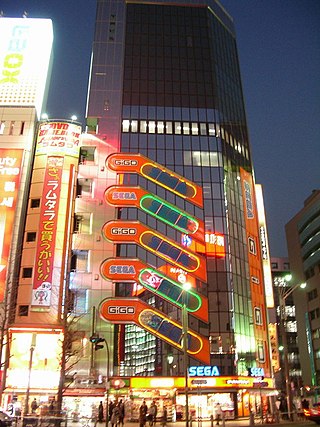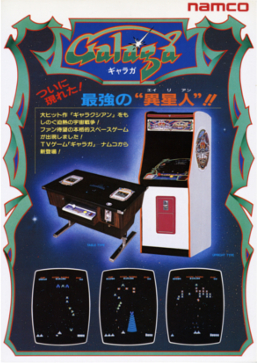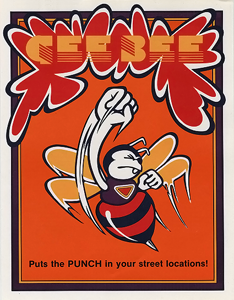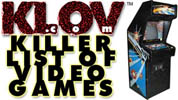
An amusement arcade, also known as a video arcade, amusements, arcade, or penny arcade, is a venue where people play arcade games, including arcade video games, pinball machines, electro-mechanical games, redemption games, merchandisers, or coin-operated billiards or air hockey tables. In some countries, some types of arcades are also legally permitted to provide gambling machines such as slot machines or pachinko machines. Games are usually housed in cabinets.

Atari Games Corporation, known as Midway Games West Inc. after 1999, was an American producer of arcade games. It was formed in 1985 when the coin-operated arcade video game division of Atari, Inc. was transferred by Warner Communications to a joint venture with Namco. It was one of several successor companies to use the name Atari. The company developed and published games for arcades and across consumer gaming consoles such as the Commodore 16, Commodore 64, Game Boy, Nintendo Entertainment System (NES) and other platforms using the Tengen label. Some of the games Atari had developed include Tetris, Road Runner, RoadBlasters and Primal Rage. After Time Warner reassumed full ownership in 1994, the company was sold to WMS Industries in 1996, and became part of Midway Games when that company was spun-off by WMS in 1998. It ceased operations in 2003 and its former assets were sold back to Warner Bros. Interactive Entertainment in 2009 following Midway's bankruptcy.

Data East Corporation, also abbreviated as DECO, was a Japanese video game, pinball and electronic engineering company. The company was in operation from 1976 to 2003, and released 150 video game titles. At one time, the company had annual sales of 20 billion yen in the United States alone but eventually went bankrupt. The American subsidiary, Data East USA, was headquartered in San Jose, California. Its main headquarters were located in Suginami, Tokyo.

Qix is a 1981 puzzle video game developed by husband and wife team Randy and Sandy Pfeiffer and published in arcades by Taito America. Qix is one of a handful of games made by Taito's American division. At the start of each level, the playing field is a large, empty rectangle, containing the Qix, an abstract stick-like entity that performs graceful but unpredictable motions within the confines of the rectangle. The objective is to draw lines that close off parts of the rectangle to fill in a set amount of the playfield.

Galaga is a 1981 fixed shooter arcade video game developed and published by Namco. In North America, it was released by Midway Manufacturing. It is the sequel to Galaxian (1979), Namco's first major video game hit in arcades. Controlling a starship, the player is tasked with destroying the Galaga forces in each stage while avoiding enemies and projectiles. Some enemies can capture a player's ship via a tractor beam, which can be rescued to transform the player into a "dual fighter" with additional firepower.
Chicago Coin was one of the early major manufacturers of pinball tables founded in Chicago, Illinois. The company was founded in 1932 by Samuel H. Gensburg and Samuel Wolberg to operate in the coin-operated amusement industry. In 1977, Gary Stern and Sam Stern purchased the assets of the Chicago Coin Machine Division as it was then called to found Stern Electronics, Inc. They also produced various arcade games during the 1960s to 1970s.
Stern is the name of two different but related arcade gaming companies. Stern Electronics, Inc. manufactured arcade video games and pinball machines from 1977 until 1985, and was best known for Berzerk. Stern Pinball, Inc., founded in 1986 as Data East Pinball, is a manufacturer of pinball machines in North America.
The golden age of arcade video games was the period of rapid growth, technological development, and cultural influence of arcade video games from the late 1970s to the early 1980s. The release of Space Invaders in 1978 led to a wave of shoot-'em-up games such as Galaxian and the vector graphics-based Asteroids in 1979, made possible by new computing technology that had greater power and lower costs. Arcade video games switched from black-and-white to color, with titles such as Frogger and Centipede taking advantage of the visual opportunities of bright palettes.

Cinematronics Incorporated was an arcade game developer that primarily released vector graphics games in the late 1970s and early 1980s. While other companies released games based on raster displays, early in their history, Cinematronics and Atari, Inc. released vector-display games, which offered a distinctive look and a greater graphic capability, at the cost of being only black and white (initially). Cinematronics also published Dragon's Lair in 1983, the first major LaserDisc video game.
Cyber Troopers Virtual-On is a series of video games created by Sega AM3. The series was created by Juro Watari. The original series was first published for arcades in January 1996. The game features fast, action-oriented gameplay requiring quick reflexes. It has seen five installments to date and has been ported to several video game consoles.
Crazy Kong is an arcade game developed by Falcon, released in 1981 and similar to Nintendo's Donkey Kong. Although commonly believed to be a bootleg version, it was officially licensed for operation only in Japan when Nintendo couldn't keep up with domestic demand, and is based on different hardware. It retains all the gameplay elements of Donkey Kong, but its graphics were redrawn and re-colorized. Falcon breached their contract by exporting the cabinets overseas, leading Nintendo to revoke the license in January 1982. Like the original game, Crazy Kong had bootleg versions under such titles as Congorilla, Big Kong, Donkey King and Monkey Donkey.

Gee Bee is a block breaker/video pinball hybrid arcade game developed and published by Namco in 1978. The player controls a set of paddles with a rotary knob, with the objective being to score as many points as possible by deflecting a ball against bricks, pop bumpers and other objects in the playfield. It was developed by Toru Iwatani, known as the creator of Pac-Man and Pole Position. Outside Japan, it was published by Gremlin Industries.
Centuri, formerly known as Allied Leisure, was an American arcade game manufacturer. They were based in Hialeah, Florida, and were one of the top six suppliers of coin-operated arcade video game machinery in the United States during the early 1980s. Centuri in its modern inception was formed when former Taito of America president Ed Miller and his partner Bill Olliges took over Allied Leisure, Inc. They renamed it "Centuri" in 1980.

Timber is an arcade game manufactured by Bally Midway in 1984. The goal is to amass points by chopping down trees, then logrolling in bonus rounds. Two players can compete simultaneously in the same play area. Timber was designed by Steve Meyer, who also designed Tapper, and both games have a similar audio/visual style.
GameRoom Magazine is an American magazine focusing on game room products. It was founded in 1988 by Dave C. and Donna Cooper of New Albany, Indiana, and was created to serve the growing market of coin-op memorabilia collectors, hobbyists, and restorers. The first issue, dated January 1989, focused on jukeboxes. The magazine also covered other coin-operated playthings, such as pinball machines, slot machines, and gumball machines, in addition to related items such as carousels, gas station memorabilia, and antique ice cream scoops.
Electro-mechanical games are types of arcade games that operate on a combination of some electronic circuitry and mechanical actions from the player to move items contained within the game's cabinet. Some of these were early light gun games using light-sensitive sensors on targets to register hits, while others were simulation games such as driving games, combat flight simulators and sports games. EM games were popular in amusement arcades from the late 1940s up until the 1970s, serving as alternatives to pinball machines, which had been stigmatized as games of chance during that period. EM games lost popularity in the 1970s, as arcade video games had emerged to replace them in addition to newer pinball machines designed as games of skill.

Zaccaria, was an Italian company of pinball and arcade machines that existed in Bologna from 1974 until 1990. The factory was sold to tecnoplay.

An arcade game or coin-op game is a coin-operated entertainment machine typically installed in public businesses such as restaurants, bars and amusement arcades. Most arcade games are presented as primarily games of skill and include arcade video games, pinball machines, electro-mechanical games, redemption games or merchandisers.










